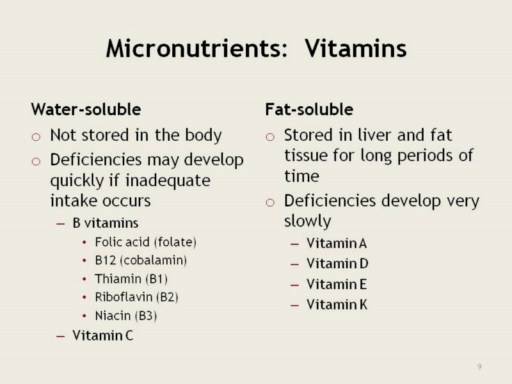| front |1 |2 |3 |4 |5 |6 |7 |8 |9 |10 |11 |12 |13 |14 |15 |16 |17 |18 |19 |20 |21 |22 |23 |24 |25 |26 |27 |28 |29 |30 |31 |32 |33 |34 |review |
 |
Vitamins are organic compounds essential for normal functioning, growth and maintenance of the body.
Vitamins C and E function as antioxidants. Vitamin C is also essential in the formation of collagen and connective tissue. Vitamin C is found in fruits and vegetables with citrus fruits being one of the best sources of vitamin C.
Most B vitamins work as co-enzymes (they assist the enzyme in itís job, or get the enzyme working faster) in metabolic reactions including the Krebís Cycle, electron transport, glycogen breakdown, red blood cell formation, hormone synthesis, and nucleic acid synthesis. B vitamins are fairly wide-spread in the diet and can be found in whole grains, fruits, vegetables and legumes.
Vitamin B12 acts in DNA and amino acid metabolism. Cobalamin is found in animal foods (meat, poultry, and fish), fortified cereals, and is also synthesized by gut bacteria.
Vitamin A is important for gene transcription, visual functioning in the production of rhodopsin, immune function, and epithelial tissue development. Food sources of vitamin A include liver, egg yolks, and fortified dairy (and most non-dairy alternative) products.
Vitamin D is required for calcium metabolism, insulin secretion, immune function, and blood pressure regulation. Food sources of vitamin D are rather limited, but vitamin D is found in egg yolks and fortified dairy (and most non-dairy alternative) products.
Vitamin K is needed for blood clotting, bone mineralization, and cellular growth. Vitamin K is synthesized by gut bacteria and can be consumed in the diet by eating dark green leafy vegetables (e.g., kale, broccoli, collard greens, etc).
Water soluble vitamins are not stored, so these deficiencies appear more quickly than those associated with fat-soluble vitamins. Fat soluble vitamin deficiencies may take months or years to appear, where as water soluble vitamin deficiencies only take weeks to appear. |